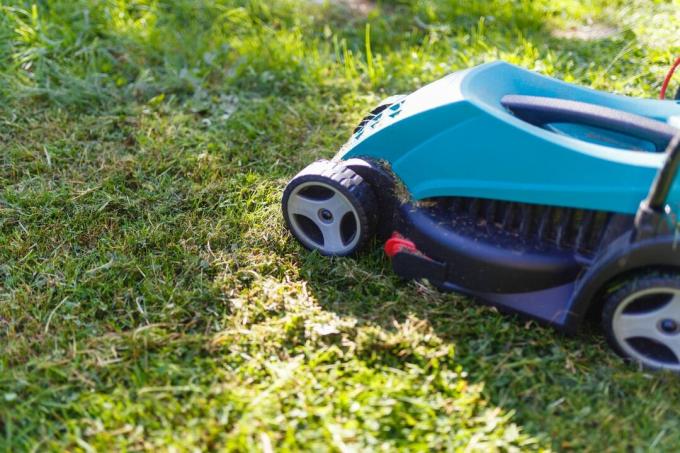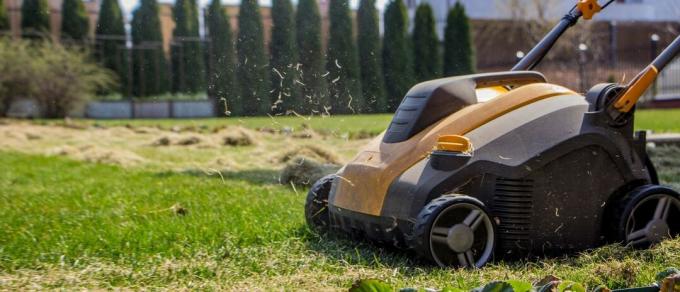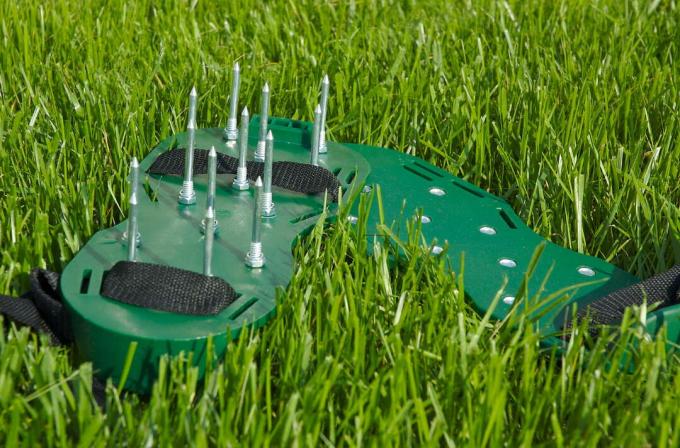Scarifying the lawn removes thatch and moss and promotes good lawn growth.We'll show you why it's worth it and give you detailed instructions.
With lawn care it is like with health care: Consuming fruit and vegetables regularly is far less strenuous than curing a long cold or the flu. It is up to each lawn owner to decide whether he or she would like to take a little effort to maintain the lawn or wait until the tedious one Lawn repair becomes unavoidable or even impossible at some point. Hence, we recommend scarifying the lawn before it is in worse shape.
contents
- Why scarifying the lawn is worthwhile
- How often should the lawn be scarified?
- When should the lawn be scarified?
- Instructions for scarifying the lawn
-
Maintain lawn after scarifying
- Ventilate the lawn after scarifying
- Sand the lawn after scarifying
- Re-sow and fertilize the lawn after scarifying
- Fertilize the lawn after scarifying
In the following you will find detailed instructions for scarifying your lawn as well as care tips so that your lawn recovers well after the rigors of scarifying.
Why scarifying the lawn is worthwhile
Among other things, poor soil, insufficient nutrient supply or lack of care can lead to the formation of moss and thatch in the lawn. Moss and felt worsen the growing conditions of the lawn grasses. Water and air cannot penetrate the soil as well and, in the worst case, the grass roots suffer from a lack of water and oxygen. This weakens the grass and leads to even stronger moss and felt formation. In order to break this vicious circle, moss and thatch are removed in the course of scarifying. This means that lawns that are not matted or mossy do not need to be scarified. Most hobby gardeners can hardly imagine this dream scenario, but in sunny locations with loose, Nutrient-rich and well-aerated soil, i.e. on ideal lawn locations, is actually rarely found Moss formation.

Why is it worth scarifying the lawn?
- Moss and thatch are removed
- This improves the growth conditions for the lawn grass, as water and air can penetrate the soil again and the permeability is increased
How often should the lawn be scarified?
Scarifying is carried out as required and therefore by no means at regular intervals. Unnecessary scarifying weakens the grasses more than encourages them - at least if they enjoy good growing conditions even without the intervention. Scarifying should be carried out no more than once a year, even in the case of a very poor location and unfavorable soil properties. In the long term, scarifying is of course annoying every year, so if possible you should strive to combat the causes of moss and felt formation. Here you can read about how you can do long term Remove moss from the lawn.
When should the lawn be scarified?
The optimal season for scarifying is spring, when grass is already beginning to grow. Then you should start scarifying and then apply spring fertilization with a primarily organic lawn fertilizer such as our Plantura Organic lawn fertilizer make. With this care, your lawn is optimally prepared for the warm season and has the chance to use the wounds in its roots to branch. The increasingly longer days also give him the energy to be one step ahead of the weeds and also the shade-loving moss. If you have the choice, scarifying should therefore be carried out in spring.
Early autumn to the end of September is not that good for scarifying. But because the lawn still grows slowly even at temperatures above 8 ° C, it can still use autumn to close the wounds in the lawn. After scarifying in autumn, the autumn lawn fertilization can be carried out - here is It is essential to use a potassium-accentuated, low-nitrogen autumn lawn fertilizer to prevent frost damage to the lawn avoid. We have our Plantura especially for this purpose Organic autumn lawn fertilizer designed to protect your lawn against crisp, cold temperatures. You can also find more information on how to use your Make your lawn really winter-proof.
Since their leaves and roots are injured when scarifying, the lawn plants then have to fight to regulate their water balance. Warm, humid weather, i.e. vigorous weather, optimally supports the lawn in its regeneration and ensures that it does not dry out. So if it is too dry and there is no rain forecast for the next day, you should leave the scarifier standing - or use the sprinkler.
When should the lawn be scarified?
- The perfect time to scarify is in spring, when the grass is already beginning to grow
- Scarifying in autumn is possible, but not optimal
- So that the regeneration of the lawn is not made unnecessarily difficult, scarifying should take place in warm, humid weather

Instructions for scarifying the lawn
So that you really do something good for your lawn, the right approach to scarifying is crucial. A previous deep mowing to about 2 cm and the removal of the lawn clippings is absolutely necessary so that the grass is not pulled out when scarifying. A scarifier should slightly scratch the sward and not cut the ground. The working depth of the knives must not exceed 2 to 3 millimeters, because the sward is already severely damaged when working 4 to 5 millimeters deep. When scarifying itself, the lawn should be worked on at least once lengthways and once across. Of course, you can also use a manual scarifier for this. Between the work steps and at the end, the thatch is removed with a rake, which is also much easier on a short-cut lawn.
How is the lawn properly scarified?
- Before scarifying is mowed (about 2 cm deep)
- The scarifier is set so that it only engages 2 to 3 mm in the soil surface; otherwise the grass roots can be damaged
- The lawn should be scarified at least once lengthways and once across
- In between and finally the worked out material is removed with a rake

Maintain lawn after scarifying
If the device is set correctly, scarifying only damages the grass roots as much as is necessary. Nevertheless, it presents the lawn with special, energy-sapping tasks. In order to promote the regeneration of the lawn, scarifying is followed by a few other maintenance measures.
Ventilate the lawn after scarifying
Like scarifying, this is also used Aerating (aerating) the lawn to improve the air and water permeability of the soil. But while scarifying only removes the layer of felt on the surface of the ground and the sward by lightly scratching stimulates branching, the tools penetrate 10 cm or deeper when aerating the lawn to literally close the ground "Ventilate". When aerating the lawn, the sward is punctured deeply at certain points and water, nutrients and oxygen reach the lawn roots better, which promotes their branching. The airing of the lawn serves to remove soil compaction close to the surface and can be carried out 2 to 12 times a year as required, since the entire sward remains intact. After aeration, the resulting holes are filled by sanding.

Tip: The lawn can also be aerated independently of scarifying and can also be carried out much more frequently.
Sand the lawn after scarifying
On heavy, cohesive soils, sand the soil after scarifying. By bringing in sand like ours Plantura Premium lawn sand the proportion of air-conducting coarse pores in the soil is increased and the soil structure is permanently improved in accordance with the requirements of the lawn. Soil organisms are also much better off with a better oxygen supply. That Sands of the lawn By promoting lawn plants and soil organisms, it prevents the renewed formation of moss and thatch.
Re-sow and fertilize the lawn after scarifying
It is normal for the lawn to look a little plucked after it has been scarified. An evenly thinned area of lawn will soon be covered with new green with good care. However, if there are larger bald spots, which are particularly often found in damp, shady and compacted areas in the garden, they will be re-sown after scarifying. This is important so that a closed sward is created again and renewed moss and weed infestation is prevented. the Plantura lawn reseeding or the Plantura lawn repair are ideal for treating the bald spots in your lawn. Because the lawn did not have it particularly difficult in these areas for nothing, the seedbed should be good Prepare, loosen a compacted soil well, mix it with sand and mainly organic fertilizer incorporate. Here you can read again how that is Sowing the lawn succeed.

Fertilize the lawn after scarifying
After scarifying, the lawn can be fertilized. The soil is now exposed and the fertilizer can easily be incorporated. A good supply of nutrients gives the heavily draining lawn plants the decisive advantage over unwanted weeds. However, especially if you have reseeded at the same time, you should pay attention to excessively high nutrient concentrations do without: If the soil solution contains too many nutrients, this leads to soft, vulnerable and poorly rooted young Lawn plants. You can't go wrong with one primarily organic lawn fertilizer. The slow release of this lawn fertilizer not only leads to healthier emergence for the plants, it also will by the introduction of organic material and a continuous release of nutrients the soil life promoted.
We have our Plantura for biological and long-term lawn care Organic lawn fertilizer and our Plantura Organic autumn lawn fertilizer developed. They ensure an active soil life, the lawn thatch in nutrients and humus implements. The constant supply of nutrients prevents unchecked moss growth. The mainly organic fertilization after scarifying ensures, in the medium and long term, a dense lawn without wild herbs that have to be scarified less often.

How is the lawn properly cared for after scarifying?
- Very heavy soils are also ventilated for scarifying; Ventilation can also be carried out on a monthly basis independently of scarifying, if necessary
- Sanding is compulsory after airing and has a beneficial effect on lawn growth even after scarifying
- Bald spots that have arisen during scarifying should be improved and re-sown
- After scarifying, mainly organic fertilizers should be used to prevent the formation of moss and felt over the long term; we recommend ours in spring Plantura organic lawn fertilizer and ours in autumn Plantura organic autumn lawn fertilizer - for a frost-hard lawn
More about the right one Lawn care all year round You will find here.
